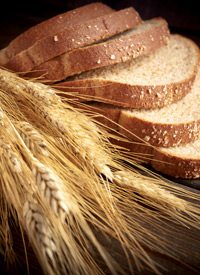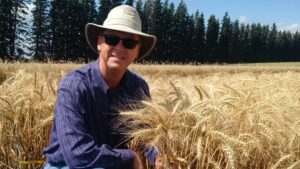
As industry adapts to the new marketing era in Western Canada, and investment in wheat breeding increases, will new varieties of wheat jeopardize the high standards of quality Canada has become known for? The final installment of a three-part series on the new marketing era.
The new marketing era in Western Canada has been fully implemented. Farmers are slowly trying out new marketing channels and grain flows have already shifted. Under the CWB, most durum was shipped east but this year some is moving through Vancouver and the United States, according to various grain specialists.
From a research and development perspective, however, the industry is still waiting to see what effects the new marketing era will have on new varieties of wheat. According to Suzi Beck, media relations coordinator for the Canadian Food Inspection Agency, “the government expects there to be increased interest and private investment in the wheat sector as a result of marketing freedom.” In the past, increased investment in a crop type has led to new varieties, and most seed and grain industry professionals agree this is finally wheat’s time to shine.
“There will be excellent marketing opportunities for high-yielding wheat in Canada, in particular for Canada Prairie Spring Red and Canada Western Red Winter wheats.” —Nancy Edwards
“There will be excellent marketing opportunities for high-yielding wheat in Canada, in particular for Canada Prairie Spring Red and Canada Western Red Winter wheats,” says Nancy Edwards, program manager for bread wheat research for the Canadian Grain Commission. “One of the largest market classes in the world is U.S. Hard Red Winter, and the quality characteristics of the newer varieties of CPSR put it in a position to very effectively compete with U.S. HRW for those markets,” she says. “There are varieties of CWRW, and more in the pipeline, that will also be very strong competitors in those markets.”
|
The bottom line, whether tweaks are made to variety registration or not, is ensuring an environment in which the industry can capitalize on new opportunities in wheat without losing sight of quality. |
What About Quality?
With the removal of the CWB monopoly, and the opportunity for new varieties of wheat to enter the marketplace, what impact will this have on quality? Edwards says, first of all, it is a misconception to consider CPSR, CWRW or U.S. HRW low-quality wheat.
“They are typically lower in protein content and therefore not suitable on their own for making high-volume pan breads or sandwich loaves, but they are all nonetheless high-quality wheats with excellent milling and baking properties,” she says. “On their own they would be used for production of hearth breads, baguettes, rolls, and so on, as well as applications in other products such as noodles, steam buns and pizza dough.”
In addition, Edwards says quality requirements are regularly reviewed as part of the variety registration process in Canada. Quality requirements for registration of western wheat varieties are the responsibility of the Prairie Recommending Committee for Wheat, Rye and Triticale. Brian Beres, chair of the PRCWRT and an agronomist at Agriculture and Agri-Food Canada’s Lethbridge Research Centre, says irrespective of the CWB monopoly, quality specs should be reviewed as domestic and export markets evolve.
“The entire value chain will respond. For example, quality changes and requests from customers, or a desire to access new markets, led to the creation of the Canada Prairie Spring, Canada Western Extra Strong and Canada Western General Purpose classes. Moving ahead, I can see a class like CPS evolve further so that the quality specs may someday mirror that of the Dark Northern Spring in the United States. This would, as I understand from colleagues in the grain marketing sector, enhance variety development and sales on both sides of the border.”
Streamlining Variety Registration
Since the end of the CWB monopoly, there has been increased discussion surrounding the variety registration process in terms of tweaking it to allow varieties to come to market faster. This has nothing to do with quality requirements, but rather touches on length of time it takes to get a variety to market.
“SeCan has been quite involved in the consultation process in terms of evolving the wheat registration system in Canada,” says Jeff Reid general manager of SeCan. “It’s our feeling that the system isn’t broken, it just needs to be tweaked somewhat. I think our Canada Western Red Spring and western durum classes need to be preserved because those are the flagship commodities of Canada in terms of export wheat. But we do feel and recognize that there is an opportunity to enhance the CPS and the general purpose classes to make more diversity available to farmers and to really enhance the gene pool that’s available to breeders. So if we can open those classes up somewhat, I think that’s going to be very beneficial to the seed industry and to farmers across Canada.
The Canadian Seed Trade Association, recognizing the need for a more streamlined and efficient system to attract investment and deliver a greater choice for farmers, facilitated a value chain process to examine and recommend improvements to the western wheat variety registration system. The process, which started with a facilitated working session and carried on with dialogue and consultations, came to a number of conclusions.
“I can see a class like CPS evolve further so that the quality specs may someday mirror that of the Dark Northern Spring in the United States.” —Brian Beres
“There was a consensus that the CWRS and CWAD classes were important for the Canadian quality brand, and should be maintained,” says CSTA’s CEO, Patty Townsend. “However participants also concluded that in order to broaden the germplasm base available to breeders, and to accommodate the introduction of new varieties to farmers, the CPS class should be redefined to support registration of medium-high quality wheat varieties designed to compete with U.S. Hard Red Winter, Eastern European Winter, Argentine Winter and Dark Northern Spring milling wheat varieties.” The quality evaluation team of the PRCWRT were presented with recommendations to change quality parameters around hardness, flour ash and yield, dough and baking strength.
The process facilitated by CSTA also considered some options to streamline the entire wheat variety registration system. Some of the options presented to the PRCWRT for consideration and discussion include the following:
• Reducing the number of checks by consolidating by purpose where possible.
• Re-evaluation of how disease evaluations are conducted, and the diseases for which evaluations should be included.
• Maintaining three years of testing, but with more flexibility by requiring:
– Two years of co-op trials preceded by one strong year of scientifically valid data from another source, including data from U.S. trials.
or
–Two years of co-op trials on which interim registration would be based, followed by one more year of trials to confirm registration.
• Acceptance of testing data from additional laboratories.
Shift in Focus
Edwards says in the past, because of its monopoly, CWB was in a position to provide much of the feedback from end users of Canadian wheat which was used to develop quality targets that breeders would incorporate into their breeding programs with most of the focus on CWRS and Canada Western Amber Durum.
“However, with the loss of the CWB monopoly, there is a need to draw that information from other sources which will almost certainly bring wider ranging opinions and more focus on some of the wheat classes outside of CWRS and CWAD,” says Edwards.
Beres also thinks there might be an increased demand for customer specifications rather than class, which will further benefit the smaller classes. “I think winter wheat is poised to receive more interest than what it has in the past,” he says.
Edwards agrees and says they are already seeing increased demand in customer specifications. “A customer may find that a certain variety or group of varieties works particularly well for their process and they may want only those varieties with the caveat that they meet certain performance requirements,” she says. “There is already precedent set with Warburtons Bakery from the U.K. contracting specific varieties.”
Edwards lists starch characteristics, dough strength properties and minimum vitreous kernel count as examples of specifications that a customer might ask for. However, she says in order to supply wheat based on specification there would be a cost involved in sourcing that wheat and keeping that material segregated throughout the handling system.
“The customer would have to determine if the benefit of purchasing wheat meeting their specifications, as opposed to grade, outweighs the cost of obtaining that wheat,” she says. “If there were to be wholesale change to the variety registration system and quality was no longer a requirement, then we would see considerable movement to purchase by specification because processing performance would no longer be predictable and, of course, there would be a cost associated.”
“If there were to be wholesale change to the variety registration system and quality was no longer a requirement, then we would see considerable movement to purchase by specification because processing performance would no longer be predictable and, of course, there would be a cost associated.” —Nancy Edwards
Balancing Act
There is no reason that development of high-yielding varieties should be mutually exclusive from producing a high-quality product, says Edwards. “There seems to be a lot of confusion between low-quality wheat and low-protein content wheat. You can have very high-quality wheat in terms of agronomic performance and processing performance that does not have the same high-protein content as CWRS, for example CPSR and CWRW,” she says.
“Protein content generally exhibits an inverse relationship with agronomic yield. Breeding programs can target high yield and at the same time target good milling and end product performance when there is not the expectation of high-protein content. There will always be a portion of the market that wants the quality and protein content of CWRS wheat; however, there is huge opportunity for high-yielding, high-quality, lower-protein content wheat like CPSR and CWRW,” adds Edwards.
According to Beres, having a diversified set of market classes allows the Canadian market to balance quality and yield. “Given the inverse relationship between yield and quality parameters like protein it is hard to capture everything in one class of wheat; and different markets call for different quality specs,” explains Beres. “It also helps to rid the system of quality parameters that create bottlenecks to genetic gain. A classic example is KVD, which prevented the registration of a new winter wheat variety for almost a decade and hampered or killed the release of other cultivars from various classes. When KVD was abolished in 2008, this opened the door to an increased pace of innovation for winter wheat cultivar development and genetic gain across most classes. I don’t think people realize what a significant impact the removal of KVD has made because we are just starting to reap the benefits.”
The bottom line, whether tweaks are made to variety registration or not, is ensuring an environment in which the industry can capitalize on new opportunities in wheat without losing sight of quality. “I think it would be short-sighted to lose our focus on quality,” says Edwards. “Canada is a relatively small wheat producer, sixth globally, but a large exporter—second or third globally, so we are heavily reliant on the export market. We have developed a very strong brand with high-quality wheat, which to this point has primarily been dominated by CWRS and CWAD. I believe that there is a lot of untapped potential in the high-quality but lower-protein content CPSR and CWRW wheat classes.”
Julie McNabb
Read the first two installments of this three part series:













